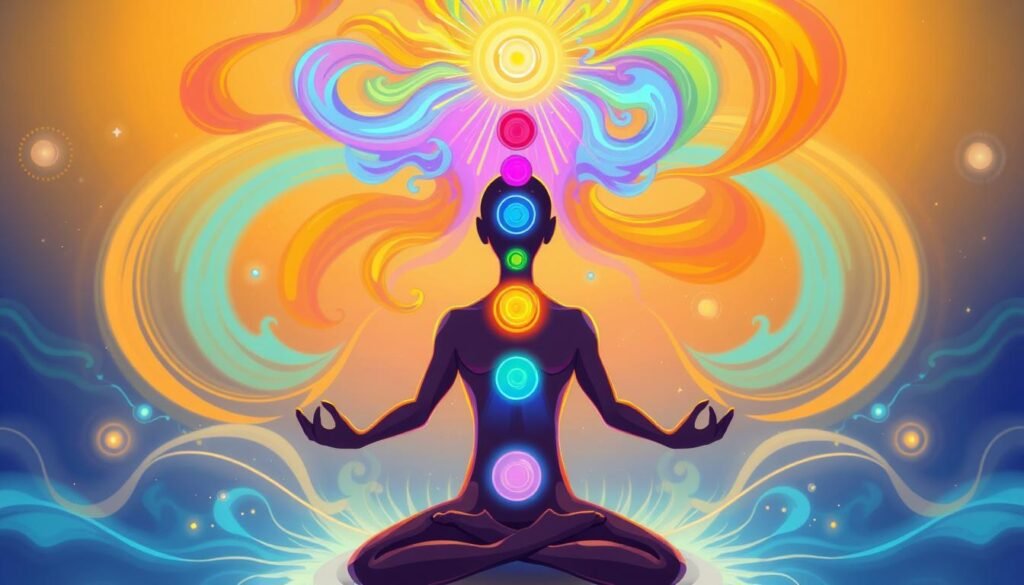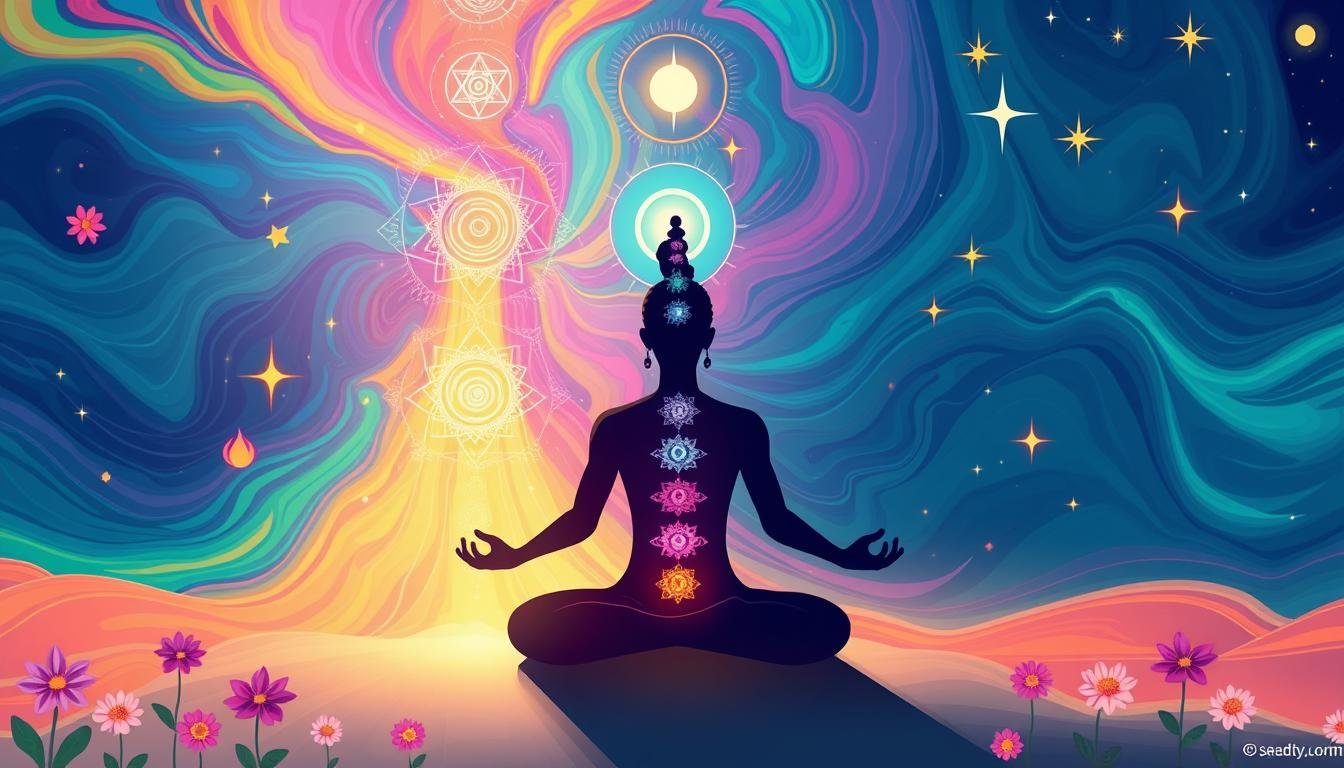What Are the Signs of a Kundalini Awakening?
“The kundalini rises from the muladhara chakra up through the spinal channel, and it is experienced as a feeling of heat or burning.” – Swami Vivekananda
Kundalini awakening is a deep spiritual journey. It’s not a medical issue, but a transformative process. Many seekers mistake it for a problem, but it’s a natural part of growth.
This awakening can happen fast or slow. Some feel it right away, while others notice subtle changes over time. The signs of kundalini rising are varied and unique to each person.
Common kundalini rising symptoms include a surge of energy, tingling sensations, and intense emotions. You might feel more connected to nature or have vivid dreams. Some people report feeling blissful or deeply calm.
Spiritual awakening kundalini can be triggered by life events or practices. Yoga, meditation, and even tough times can spark it. It’s a powerful process that can change how you see the world.
Understanding these signs helps navigate the awakening. It’s not always easy, but it can lead to personal growth and deeper spiritual awareness. If you’re curious about your own journey, pay attention to these subtle shifts in your body and mind.
Understanding Kundalini Energy
Kundalini energy is a powerful force at the base of the spine. It’s often seen as a coiled serpent. This energy has great potential for spiritual growth and change.
The idea of kundalini shakti awakening comes from ancient spiritual traditions. It’s thought that this energy moves up through the body’s energy centers, or chakras. This movement can cause many physical, emotional, and spiritual experiences.
Kundalini energy can be released in different ways. Some people feel it suddenly, while others seek it through yoga or meditation. It’s key to understand that kundalini awakening is complex and should be handled with care and guidance.
Signs of kundalini awakening include:
- Intense heat or energy sensations along the spine
- Heightened awareness and intuition
- Spontaneous body movements or yoga postures
- Emotional releases and processing of past traumas
- Altered states of consciousness
Kundalini awakening can lead to deep spiritual insights and personal growth. Yet, it can also bring challenges. Some people feel physical discomfort, emotional turmoil, or psychological stress. It’s vital to approach kundalini energy work with respect and seek help from experienced practitioners when needed.
The Nature of Kundalini Awakening
Kundalini awakening is a deep spiritual experience that changes one’s life path. It starts with the awakening of energy at the base of the spine. This energy affects the mind, body, and spirit in big ways.
Definition and Concept
Kundalini awakening is when hidden energy moves up through seven centers in the spine. This can cause strong physical feelings, change how you see the world, and connect you deeply with the universe. Research shows that 70% of people feel physical pain, and 62% go through big emotional changes.
Historical and Cultural Context
The idea of kundalini awakening comes from ancient yoga teachings. It’s mentioned in the Upanishads, showing its importance for centuries. Now, people all over the world try to experience it through meditation, yoga, and breathwork.
Importance in Spiritual Growth
Kundalini awakening is key for spiritual growth. It can make you more aware, creative, and connected to the divine. Amazingly, 71% of those who experience it feel closer to nature. Some people wake up to it suddenly, while others work for it through spiritual practices.
“Kundalini awakening is like a rebirth. It opens doors to higher consciousness and transforms your entire being.”
Understanding kundalini awakening is vital for those on a spiritual journey. It prepares you for the challenges and rewards of this powerful experience.
Common Misconceptions About Kundalini Experiences
Kundalini awakening symptoms often spark confusion and misunderstanding. Many believe it’s a one-time event, but it’s actually a lifelong journey. This journey can be reactivated repeatedly. The idea that only a guru can trigger this process is a myth. Kundalini rising signs are accessible to everyone, not just those under the guidance of a spiritual teacher.
Another widespread misconception is that any bodily twitch or itch signifies a Kundalini awakening. In reality, these are usually just normal physical sensations. It’s crucial to distinguish between everyday occurrences and genuine kundalini awakening symptoms.
Contrary to popular belief, Kundalini energy can’t be controlled or stopped once awakened. It’s a powerful force meant to elevate consciousness, not something to be manipulated. Some erroneously compare the experience to being high, but it’s more akin to an intense emotional release.
“Kundalini Yoga connects you with the energy of your being, enhancing your sense of spirit.”
It’s important to note that while practices like yoga and meditation can contribute to a Kundalini experience, they don’t guarantee it. The energy originates at the base of the spine and moves upward through the chakras, not randomly as some mistakenly believe. Understanding these facts helps dispel fears and promotes a more accurate view of this profound spiritual process.
Kundalini Awakening Signs
The kundalini activation process shows itself in many ways. These signs can be seen in the body, emotions, and spirit. Knowing these signs helps people move through the awakening stages better.
Physical Signs
When kundalini awakens, the body might feel strange. You could see sudden movements, feel tingles, or sleep differently. Some feel energy moving up their spine or get sudden body jerks.

Emotional and Mental Signs
Emotions can change a lot during this time. You might feel very emotional, more intuitive, and see things differently. Many feel more empathy, get deep insights, and feel free from ego thoughts.
Spiritual and Energetic Signs
The spiritual side of kundalini awakening is deep. People feel closer to the universe, more compassionate, and sense oneness. Some see visions, hear odd sounds, or feel beings not seen by others.
“Kundalini awakening can lead to self-realization, bliss, and increased creativity,” notes Krishna Kaur, a kundalini yoga teacher.
Remember, these signs are different for everyone. The kundalini process is unique to each person. If you’re going through this, getting help from experts can be very helpful. They can guide you through this journey safely and well.
The Role of Chakras in Kundalini Awakening
Chakras are key in kundalini energy release. These energy centers along the spine are gateways for kundalini shakti. As this force awakens, it clears blockages and brings balance to each chakra.
The journey starts at the root chakra, Muladhara. This red-hued center grounds us and is the start of kundalini awakening. Then, the energy moves up, activating each chakra in order:
- Svadhishthana (sacral): linked to creativity and emotions
- Manipura (solar plexus): associated with willpower and digestion
- Anahata (heart): connected to love and compassion
- Vishuddha (throat): related to self-expression and purification
- Ajna (third eye): tied to intuition and inner wisdom
- Sahasrara (crown): represents spiritual connection and enlightenment
As kundalini shakti awakens, people may see big changes. For example, the solar plexus chakra, which deals with personal power, can make us more alert and efficient. The heart chakra opening can fill us with compassion. And the third eye activation can boost our intuition.
Knowing about these energy centers helps us understand kundalini awakening. By working with each chakra, we support the kundalini’s journey. This helps us grow and transform personally.
Triggers of Kundalini Awakening
Kundalini awakening can happen in many ways. It can come from intentional practices or unexpected life events. Knowing these triggers helps people understand and follow their spiritual path.
Spiritual Practices
Many people wake up their kundalini through spiritual practices. Kundalini yoga is a common method. It uses special postures, breathwork, and meditation.
Regular meditation, pranayama, and energy healing like Reiki can also awaken kundalini energy.
Life Events and Traumas
Life-changing events can also trigger kundalini awakenings. These include:
- Traumatic experiences or shocks
- Childbirth
- Near-death experiences
- Intense psychological stress
- Dark nights of the soul
These events can shake our beliefs and open us to deep spiritual changes.
Spontaneous Awakenings
Spontaneous kundalini awakening can happen without warning. Some people wake up during everyday activities or while reading spiritual books. Being around others with active kundalini energy can also start an awakening.
“My spontaneous kundalini awakening happened while meditating with a book by Gabby Bernstein. It was unexpected and life-changing.”
Kundalini awakening, whether planned or unexpected, is a powerful spiritual experience. It can lead to deep personal growth and change.
Kundalini Rising Symptoms
Kundalini rising symptoms can be intense and varied. People often feel tingling or heat along their spine. Some experience pressure in their head or sudden bursts of energy.
Emotional changes are common during kundalini awakening. You might feel euphoric one moment and anxious the next. Vivid dreams or visions can occur. Many become more sensitive to their surroundings.
- Involuntary body movements
- Changes in appetite
- Temperature fluctuations
- Hearing unusual sounds
The kundalini activation process can happen spontaneously or after years of spiritual practice. It’s not always comfortable. Some people feel like they’re floating or being pressed into the ground. Others experience involuntary laughing or crying.
“Kundalini awakening is an automatic process that can occur under any spiritual discipline,” says Kundalini yoga teacher Krishna Kaur.
While kundalini rising symptoms can be challenging, many report positive outcomes. These include increased creativity, empathy, and a sense of spiritual growth. It’s important to approach this process with care and seek guidance when needed.
Navigating the Kundalini Awakening Process
Starting a kundalini awakening journey is exciting and tough. Knowing the stages and using helpful practices can make it easier. This way, you can understand and enjoy the change.
Supportive Practices
Doing kundalini yoga is a great way to support your journey. It mixes physical poses, breathing, and meditation to move kundalini energy. This helps handle the strong feelings and sensations that come with awakening.
Seeking Guidance
It’s important to find a good teacher or mentor. They can share important knowledge, answer your questions, and support you when it’s hard. Many have spent years studying and teaching about kundalini awakening.
Integrating the Experience
Integration is key in the kundalini awakening process. It’s about getting used to new feelings and staying balanced in everyday life. This might mean doing meditation, journaling, or other activities that help you reflect.
“The end goal of spiritual awakening is paradoxical, involving both release and expansion, as well as contraction and individuation.”
By using supportive practices, getting guidance, and focusing on integration, you can move through your kundalini awakening smoothly. Be kind to yourself and celebrate your own path through this deep spiritual change.
Potential Challenges and Risks
Kundalini awakening symptoms can be intense and overwhelming for some. While many see positive changes, others face challenges. The rising energy may cause physical discomfort, emotional turmoil, or psychological distress.
Common signs include energy rushes, body heat, shaking, anxiety, fear, headaches, and insomnia. In severe cases, some people may need to stay in bed. These symptoms can be scary and confusing if not understood.
Spontaneous awakenings, often caused by trauma, drug use, or head injuries, can be tough. Without the right guidance, people may struggle to cope. This can lead to anxiety, depression, or even psychosis in rare cases.
“Finding a qualified teacher is essential for safely navigating the process of Kundalini awakening and minimizing the risks associated with it.”
To deal with tough symptoms, experts suggest slowing down and stopping some practices. This includes advanced breathing, mudras, bandhas, and reading spiritual texts in severe cases. By being cautious and seeking support, individuals can have a safe and positive experience.
Long-term Effects of Kundalini Awakening
A kundalini awakening brings deep changes that touch every part of life. It changes people from the inside out. This change leaves a lasting mark on their growth and view of the world.
Personal Transformation
The kundalini experience signs often include a deep shift in personality. Many report increased creativity and enhanced intuition. Some find themselves drawn to new interests or rediscovering long-forgotten passions.
This transformation can lead to a more authentic way of living. It’s a way of living that’s aligned with one’s true self.
Spiritual Growth
A spiritual awakening kundalini often results in accelerated spiritual development. People may experience a deeper connection to the universe and a heightened sense of purpose. Some report seeing auras, flashes of light, or even spiritual beings.
These experiences can lead to a more profound understanding of life’s mysteries.
Life Changes
The effects of a kundalini awakening extend beyond the internal realm. Many individuals find their relationships, career paths, and personal values shifting. Some experience changes in diet and appetite. Others feel compelled to move their bodies in specific ways, known as Kriyas.
These changes can be challenging but often lead to a more fulfilling life.
- Increased creativity and intuition
- Deeper spiritual connection
- Shifts in relationships and career
- Changes in diet and physical sensations
While the kundalini awakening journey can be intense, it ultimately leads to profound personal growth. It leads to a more spiritually aligned existence. Understanding these long-term effects can help individuals navigate this transformative experience with greater ease and appreciation.
Kundalini Awakening vs. Other Spiritual Experiences
The spiritual awakening kundalini process is unique. It brings intense, transformative power that shakes a person deeply. Unlike general spiritual awakenings, which are gentle and gradual, kundalini is dramatic and physical.
Kundalini experiences often involve energy shifts in the body. People feel tingling sensations, warm glows, and sudden energy bursts. These physical signs are rare in other spiritual experiences, which are more mental or emotional.
The aftermath of kundalini awakenings is also distinct. They often lead to enhanced psychic abilities like clairvoyance or clairsentience. People also feel a strong need for solitude and introspection. Other spiritual experiences may not have such a deep impact on a person’s life.
It’s important to recognize these differences. This helps identify a kundalini awakening and find the right guidance. While general spiritual growth might benefit from meditation or self-help books, kundalini needs specialized support from experienced teachers or energy workers.
Source Links
- Part 7: Kundalini Awakening Signs and Symptoms — Brent Spirit – Spiritual Guide Offering Kundalini Awakening Support
- How do I know if I might be experiencing a Kundalini Awakening? – The BioMedical Institute of Yoga & Meditation
- What Exactly Is a Kundalini Awakening?
- What is a Kundalini Awakening and Have I Had One? • Kara-Leah
- What is Kundalini Awakening?: Benefits, Symptoms, and More
- What is Kundalini Awakening? (19 Intense Symptoms)
- 16 Key Symptoms of Kundalini Awakening • Yoga Basics
- 8 Kundalini Awakening Signs and Symptoms | Gaia
- Part 3: Kundalini, Energetic Balance, and Staying Grounded — Brent Spirit – Spiritual Guide Offering Kundalini Awakening Support
- The 9 most popular myths and misconceptions about Kundalini
- Kundalini 101: Is It Really Dangerous? 6 Common Myths—Debunked
- Kundalini Awakening: Symptoms, Process, Benefits, Support & Help • Kara-Leah
- 15 Signs You’re Having A Kundalini Awakening + What It Means
- Signs of Kundalini Awakening. – Siddhyog Meditation
- The 7 Chakras and Kundalini Energy – Google Arts & Culture
- About 7 Chakras Awakening in Human Body – Kundalini Yogic Science
- Kundalini Awakening & the 7 Demons of the Chakras. | elephant journal
- What Triggered Your Kundalini Awakening? – Myree Morsi
- Kundalini Awakening: Symptoms, Stages, & How to Guide
- The State after Self Realization
- Kundalini Awakening Symptoms
- The First Stage of Kundalini Awakening
- Kundalini, Awakening and Exhaustion – Myree Morsi
- Dealing with a Painful Kundalini Awakening – Advanced Yoga Practices Int.
- Kundalini Awakening: A Guide to the Process and Its Potential Benefits and Risks
- Kundalini Awakening and Kundalini Experiences – Spiritual Awakening Process
- Kundalini Awakening or Spiritual Awakening? What’s the difference?








